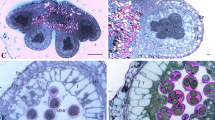Abstract
Knowledge on the distribution and storage of different organic compounds during basidiosporogenesis in P. microcarpus is paramount to a better understanding of basidiospore recalcitrance to germination. The objective of this work was to detect the presence and distribution of phenolics, reducing sugars, starch, glycogen, total polysaccharides, RNA, and proteins during P. microcarpus basidiosporogenesis. Starch and reducing sugars were not detected in the fungal basidiocarps, while other polysaccharides predominated in the extracellular matrix at the base of the basidiocarp containing unconsolidated peridioles. Phenolics were also detected in this region. Glycogen was present inside the hyphae, basidia, and basidiospores and constitutes an important storage compound in the fungal basidiocarps. In mature basidiospores, RNA accumulation occurred at discrete locations in the cytoplasmatic periphery, while polysaccharides and proteins were shown to predominate in the cell wall. The presence of glycogen, RNA, and proteins inside the basidiospores strongly indicates provision for future germination and suggests that other factors may also influence basidiospore recalcitrance.




Similar content being viewed by others
References
Bago B, Pfeffer PE, Douds DD, Brouillette J, Bécard G, Shachar-Hill Y (1999) Carbon metabolism in spores of the arbuscular mycorrhizal fungus Glomus intraradices as revealed by nuclear magnetic resonance spectroscopy. Plant Physiol 121:263–271
Bago B, Zipfel W, Williams RM, Jun J, Arreola R, Lammers PJ, Pfeffer PE, Shachar-Hill Y (2002) Translocation and utilization of fungal storage lipid in the arbuscular mycorrhizal symbiosis. Plant Physiol 128:108–124
Brundrett M, Malajczuk N, Mingqin G, Daping X, Snelling S, Dell B (2005) Nursery inoculation of Eucalyptus seedlings in western Australia and Southern China using spores and mycelium inoculum of diverse ectomycorrhizal fungi from different climatic regions. For Ecol Manag 209:193–205
Campos ANR, Costa MD, Tótola MR, Borges AC (2008) Total lipid and fatty acid accumulation during basidiospore formation in the ectomycorrhizal fungus Pisolithus sp. Rev bras Ci Sol 32:1531–1540
Chambers SM, Cairney JWG (1999) Pisolithus. In: Cairney JWG, Chambers SM (eds) Ectomycorrizal fungi: key genera in profile. Springer, Berlin, pp 1–31
Costa MD (2002) Germinação de esporos e formação de ectomicorrizas in vitro por estirpes monocarióticas de Pisolithus sp. Dissertation, Universidade Federal de Viçosa
Feofilova EP, Tereshina VM, Garibova LV, Zav’vyalova LA, Memorskaya AS, Maryshova NS (2004) Germination of basidiospores of Agaricus bisporus. Appl Biochem Microbiol 40:220–226
Fisher DB (1968) Protein staining of ribboned Epon sections for light microscopy. Histochemie 16:92–96
Gabe M (1968) Techniques histologiques. Masson et Cie, Paris
Grenville DJ, Peterson RL, Piché Y (1985) The development, structure, and histochemistry of sclerotia of ectomycorrhizal fungi. I. Pisolithus tinctorius. Can J Bot 63:1402–1411
Jensen WA (1962) Botanical histochemistry. MH Freeman and Co, San Francisco
Johansen DA (1940) Plant microtechnique. McGraw-Hill, New York
Kitamoto Y, Kobayashi A, Mori N, Ohga S (2001) Metabolic function of glycogen phosphorylase and trehalose phosphorylase in fruit-body formation of Flammulina velutipes. Mycoscience 42:143–147
Kraus JE, Arduin M (1997) Manual básico de métodos em morfologia vegetal. Editora Universidade Rural, Seropédica
Martin F (2007) Fair trade in the underworld: the ectomycorrhizal symbiosis. In: Howard RJ, Gow NAR (eds) Biology of the fungal cell, the Mycota VIII, 2nd edn. Springer, Berlin, pp 291–308
Martin F, Boiffin V, Pfeffer PE (1998) Carbohydrate metabolism and amino acid metabolism in the Eucalyptus globulus-Pisolithus tinctorius ectomycorrhiza during glucose utilization. Plant Physiol 118:627–635
Massicote HB, Melville LH, Peterson RL (2005) Building a basidiocarp: a case study of Laccaria spp. fruitbodies in the extraradical mycelium of Pinus ectomycorrhizas. Mycologist 19:141–149
McManus JFA (1948) Histological and histochemical uses of periodic acid. Stain Technol 23:99–108
Mims CW (1980) Ultrastructure of basidiospores of the mycorrhizal fungus Pisolithus tinctorius. Can J Bot 58:1525–1533
Morozova EV, Kozlov VP, Tereshina VM, Memorskaya AS, Feofilova EP (2002) Changes in lipid and carbohydrate composition of Aspergillus niger conidia during germination. Appl Biochem Microbiol 38:129–133
Nara K (2009) Spores of ectomycorrhizal fungi: ecological strategies for germination and dormancy. New Phytol 181:245–248
Osherov N, May GS (2001) The molecular mechanisms of conidial germination. FEMS Microbiol Lett 199:153–160
Pereira GMD (2004) Germinação in vitro de esporos de Pisolithus sp. Dissertation, Universidade Federal de Viçosa
Petersen GR, Dahlberg KR, van Etten JL (1983) Biosynthesis and degradation of storage proteins in spores of the fungus Botryodiplodia theobromae. J Bacteriol 155:601–606
Santos ML (2007) Composição da parede celular dos fungos ectomicorrízicos Pisolithus microcarpus e Pisolithus tinctorius. Dissertation, Universidade Federal de Viçosa
Shimomura N, Aimi A, Matsumoto T, Maekawa N, Otani H (2008) Ultrastructure of developing basidiospores in Rhizopogon roseolus (=R. rubescens). Mycoscience 49:35–41
Suh HW, Crawford DL, Korus RA, Shetty K (1991) Production of antifungal metabolites by the ectomycorrhizal fungus Pisolithus tinctorius strain SMF. J Ind Microbiol Biotechnol 8:29–35
Thines E, Weber RWS, Talbot NJ (2000) MAP kinase and protein kinase A-dependent mobilization of triacylglycerol and glycogen during appressorium turgor generation by Magnaporthe grisea. Plant Cell 12:1703–1718
Thomas SW, Rasmussen SW, Glaring MA, Rouster JA, Christiansen SK, Oliver RP (2001) Gene identification in the obligate fungal pathogen Blumeria graminis by expressed sequence tag analysis. Fungal Genet Biol 33:195–211
Umar MH, van Griensven LJLD (1998) The role of morphogenetic cell death in the histogenesis of the mycelial cord of Agaricus bisporus and in the development of macrofungi. Mycol Res 102:719–735
van Etten JL, Freer SN, McCune BK (1979) Presence of a major (storage?) protein in dormant spores of the fungus Botrydiplodia theobromae. J Bacteriol 138:650–652
Weber RWS, Wakley GE, Pitt D (1999) Histochemical and ultrastructural characterization of vacuoles and spherosomes as components of the lytic system in hyphae of the fungus Botrytis cinerea. Histochem J 31:293–301
Acknowledgments
The authors are grateful to Fundação de Amparo à Pesquisa do Estado de Minas Gerais (FAPEMIG; Project CAG 1317/06), Coordenação de Aperfeiçoamento de Pessoal de Nível Superior (CAPES), and Conselho Nacional de Desenvolvimento Científico e Tecnológico (CNPq) for the financial support.
Author information
Authors and Affiliations
Corresponding author
Rights and permissions
About this article
Cite this article
da Rocha Campos, A.N., Costa, M.D. Histochemistry and storage of organic compounds during basidiosporogenesis in the ectomycorrhizal fungus Pisolithus microcarpus . World J Microbiol Biotechnol 26, 1745–1753 (2010). https://doi.org/10.1007/s11274-010-0353-3
Received:
Accepted:
Published:
Issue Date:
DOI: https://doi.org/10.1007/s11274-010-0353-3




